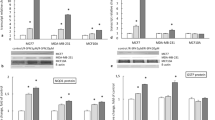Abstract
Sulforaphane significantly (p<0.05) inhibited tumor necrosis factor (TNF)-α induced cellular migration and invasion in MCF10DCIS.com human breast cancer cells, compared with controls. mRNA and protein expressions of MMPs, including MMP-2, MMP-9, and MMP-13, and the enzymatic activities of MMP-2 and MMP-9 were suppressed by sulforaphane treatments at 1, 5, and 10 μM concentration in MCF10DCIS.com cells. Sulforaphane should be considered as a potent agent for retardation of mammary tumorigenesis.
Similar content being viewed by others
References
Abdull Razis AF, Noor NM. Cruciferous vegetables: Dietary phytochemicals for cancer prevention. Asian Pac. J. Cancer Prev. 14: 1565–1570 (2013)
Houghton CA, Fassett RG, Coombes JS. Sulforaphane: Translational research from laboratory bench to clinic. Nutr. Rev. 71: 709–726 (2013)
Chiao JW, Chung FL, Kancherla R, Ahmed T, Mittelman A, Conaway CC. Sulforaphane and its metabolite mediate growth arrest and apoptosis in human prostate cancer cells. Int. J. Oncol. 20: 631–636 (2002)
Srivastava SK, Xiao D, Lew KL, Hershberger P, Kokkinakis DM, Johnson CS, Trump DL, Singh SV. Allyl isothiocyanate, a constituent of cruciferous vegetables, inhibits growth of PC-3 human prostate cancer xenografts in vivo. Carcinogenesis 24: 1665–1670 (2003)
Parnaud G, Li P, Cassar G, Rouimi P, Tulliez J, Combaret L, Gamet-Payrastre L. Mechanism of sulforaphane-induced cell cycle arrest and apoptosis in human colon cancer cells. Nutr. Cancer 48: 198–206 (2004)
Lee YR, Noh EM, Han JH, Kim JM, Hwang BM, Kim BS, Lee SH, Jung SH, Youn HJ, Chung EY, Kim JS. Sulforaphane controls TPA-induced MMP-9 expression through the NF-kappaB signaling pathway, but not AP-1, in MCF-7 breast cancer cells. BMB Rep. 46: 201–206 (2013)
Hunakova L, Sedlakova O, Cholujova D, Gronesova P, Duraj J, Sedlak J. Modulation of markers associated with aggressive phenotype in MDA-MB-231 breast carcinoma cells by sulforaphane. Neoplasma 56: 548–556 (2009)
Jemal A, Bray F, Center MM, Ferlay J, Ward E, Forman D. Global cancer statistics. CA Cancer J. Clin. 61: 69–90 (2011)
Friedel G, Pastorino U, Ginsberg RJ, Goldstraw P, Johnston M, Pass H, Putnam JB, Toomes H, International Registry of Lung Metastases LE. Results of lung metastasectomy from breast cancer: Prognostic criteria on the basis of 467 cases of the International Registry of Lung Metastases. Eur. J. Cardio-thorac. 22: 335–344 (2002)
Crawford HC, Matrisian LM. Mechanisms controlling the transcription of matrix metalloproteinase genes in normal and neoplastic cells. Enzyme Protein 49: 20–37 (1996)
Chambers AF, Matrisian LM. Changing views of the role of matrix metalloproteinases in metastasis. J. Natl. Cancer Inst. 89: 1260–1270 (1997)
Balkwill F. Tumor necrosis factor or tumor promoting factor? Cytokine Growth F. R. 13: 135–141 (2002)
Bao C, Namgung H, Lee J, Park HC, Ko J, Moon H, Ko HW, Lee HJ. Daidzein Suppresses Tumor Necrosis Factor-alpha Induced Migration and Invasion by Inhibiting Hedgehog/Gli1 Signaling in Human Breast Cancer Cells. J. Agr. Food Chem. 62: 3759–3767 (2014)
Miller FR, Santner SJ, Tait L, Dawson PJ. MCF10DCIS.com xenograft model of human comedo ductal carcinoma in situ. J. Natl. Cancer Inst. 92: 1185–1186 (2000)
Wahler J, So JY, Kim YC, Liu F, Maehr H, Uskokovic M, Suh N. Inhibition of the Transition of Ductal Carcinoma In Situ to Invasive Ductal Carcinoma by a Gemini Vitamin D Analog. Cancer Prev. Res. 7: 617–626 (2014)
Ni X, Xia T, Zhao Y, Zhou W, Wu N, Liu X, Ding Q, Zha X, Sha J, Wang S. Downregulation of miR-106b induced breast cancer cell invasion and motility in association with overexpression of matrix metalloproteinase 2. Cancer Sci. 105: 18–25 (2014)
Wu ZS, Wu Q, Yang JH, Wang HQ, Ding XD, Yang F, Xu XC. Prognostic significance of MMP-9 and TIMP-1 serum and tissue expression in breast cancer. Int. J. Cancer 122: 2050–2056 (2008)
Zhang B, Cao X, Liu Y, Cao W, Zhang F, Zhang S, Li H, Ning L, Fu L, Niu Y, Niu R, Sun B, Hao X. Tumor-derived matrix metalloproteinase-13 (MMP-13) correlates with poor prognoses of invasive breast cancer. BMC Cancer 8: 83 (2008)
Author information
Authors and Affiliations
Corresponding author
Rights and permissions
About this article
Cite this article
Bao, C., Ko, J., Park, HC. et al. Sulforaphane inhibited tumor necrosis factor-α induced migration and invasion in estrogen receptor negative human breast cancer cells. Food Sci Biotechnol 24, 347–351 (2015). https://doi.org/10.1007/s10068-015-0046-7
Received:
Revised:
Accepted:
Published:
Issue Date:
DOI: https://doi.org/10.1007/s10068-015-0046-7




